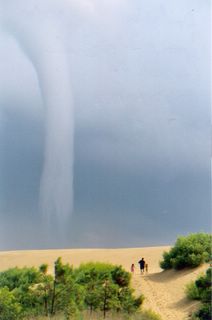Nourishment Funding and Beach Access
posted @ 5:06 PM
-
1 comments
I have long been a critic of communities that do not provide public beach access, particularly Southern Shores. When I saw this article on the Outer Banks Voice about the relationship between beach nourishment funding and public access I decided to see if I could develop a model policy that met the needs of all the county's communities.
Thanks for stopping by. Enjoy.
Beach Access Policy A Proposal
Dare County needs a public access policy. When Dare County provides public dollars to help rebuild and maintain shoreline, that shoreline should be accessible to the public. We don’t use public dollars to build private roads and we shouldn’t use public dollars to build private beaches. Public access by definition means access open and available to any member of the public without restriction
In developing this policy the County needs to recognize currently access varies widely from no public access to access that meets the rigorous federal standards[see note below] in Kill Devil Hills and most of Nags Head. Access policy must reflect this difference and encourage access where none exists while still enabling necessary investments in our key economic infrastructure, our beaches.
First the county policy should fund planning for projects without regard to access. Restricting planning funds for inaccessible beaches means those beaches will never be nourished and never be able to develop public access.
Secondly the county should require if a nourishment project does not meet a basic standard for access then 5% of the total project cost must be spent improving access. The basic standard might be 10 parking spaces for each mile of beach in the project within a quarter mile of an improved public beach crosswalk. The required access could be in one central location or spread throughout the project. If this basic standard is not met then the nourishment project would have to demonstrate that 5% of the total cost of the project is being used to improve access. This could be in the form of acquiring access easements, constructing parking or other improvements but there must be more access when the project is completed than before it started.
Funding for the access improvements need not be taken from nourishment funds. Money is available from CAMA and the Outer Banks Visitors Bureau to help with access projects. Several beach towns have successfully completed access projects by combining CAMA and OBVB funds with not local cash involved.
This approach, no access requirement for planning and a required investment for nourishment projects, allows all communities to use County funds to protect their beaches and the provides the opportunity to improve public access without penalizing those who have developed without extensive public access.
Note: The Corps regulations and guidance concerning this issue stipulate that an access shall be located every half mile with adequate parking associated with each access. In general, adequate parking has been designated as ten spaces located within a quarter mile of each access. (source Carteret County Shore Protection Office))
First the county policy should fund planning for projects without regard to access. Restricting planning funds for inaccessible beaches means those beaches will never be nourished and never be able to develop public access.
Secondly the county should require if a nourishment project does not meet a basic standard for access then 5% of the total project cost must be spent improving access. The basic standard might be 10 parking spaces for each mile of beach in the project within a quarter mile of an improved public beach crosswalk. The required access could be in one central location or spread throughout the project. If this basic standard is not met then the nourishment project would have to demonstrate that 5% of the total cost of the project is being used to improve access. This could be in the form of acquiring access easements, constructing parking or other improvements but there must be more access when the project is completed than before it started.
Funding for the access improvements need not be taken from nourishment funds. Money is available from CAMA and the Outer Banks Visitors Bureau to help with access projects. Several beach towns have successfully completed access projects by combining CAMA and OBVB funds with not local cash involved.
This approach, no access requirement for planning and a required investment for nourishment projects, allows all communities to use County funds to protect their beaches and the provides the opportunity to improve public access without penalizing those who have developed without extensive public access.
Note: The Corps regulations and guidance concerning this issue stipulate that an access shall be located every half mile with adequate parking associated with each access. In general, adequate parking has been designated as ten spaces located within a quarter mile of each access. (source Carteret County Shore Protection Office))








1 Comments:
I don't know about the topic, Bob, but you certainly get an award for most time between blog posts!
Post a Comment
<< Home